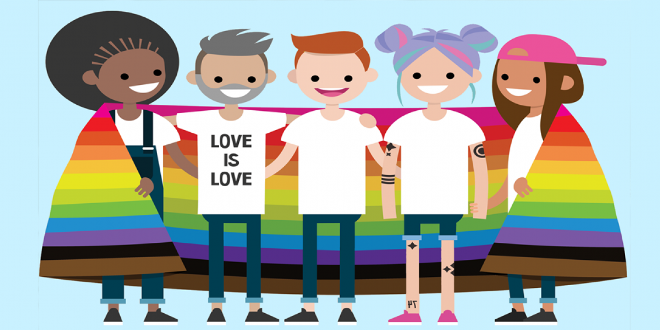Declaración de Amo sobre el tiroteo en la Universidad de Brown.

Ten years later: The instrumental role of the Affordable Care Act in LGBTQ+ health Coverage
Guillaume Bagal, diversity & inclusion lead, Blue Cross & Blue Shield of Rhode Island
In 2013, one in three LGBTQ+ individuals making less than $45,000 per year (34 percent) were uninsured. In 2014, just a year after the Affordable Care Act’s (ACA) coverage reforms came into effect, the number of uninsured LGBTQ+ individuals in this group dropped to one in four (26 percent), and by 2017, that number dropped to one in five (22 percent).[1] Signed into law 10 years ago, the ACA represents the U.S. healthcare system’s most significant regulatory overhaul and expansion of coverage since the passage of Medicare and Medicaid in 1965.
In the past, gaps in the public insurance system and lack of access to affordable private coverage left millions—both inside and outside the LGBTQ+ community—without health insurance. The ACA filled in many of these gaps by declaring nationwide insurance regulations to improve access for those who may have been previously denied coverage and by providing new coverage options with requirements for benefits and cost sharing.
In May 2016, the U.S. Department of Health and Human Services Office for Civil Rights (HHS OCR) issued a historic rule that declared nationwide nondiscrimination protections for LGBTQ+ people in health facilities, programs and activities receiving federal funds—including when obtaining health insurance coverage and healthcare. The rule was, and continues to be, critical in addressing barriers to health coverage and care that LGBTQ+ people and their families across the country routinely experience.
While LGBTQ+ individuals have many of the same health concerns as the general population, the LGBTQ+ community is also more likely to suffer from certain chronic conditions and face higher prevalence and earlier onset of health challenges compared to heterosexuals. Those challenges can include HIV/AIDS, mental illness, substance misuse and sexual/physical violence. That is unfortunately coupled with a higher likelihood of experiencing discrimination when accessing care, including prejudice or judgement, stigma or poor treatment from providers. As you can imagine, the LGBTQ+ community benefited immensely from the ACA’s ban on coverage denials.
The broadening of insurance options under the ACA through health insurance marketplaces, or exchanges, and through the expansion of Medicaid, were essential to increasing LGBTQ+ members’ access to personalized, cost-efficient care. With the new rule preventing insurers from denying coverage to people for any reason, many in the LGBTQ+ community could finally feel some sense of protection and confidence in their health and financial well-being. Research now shows that regardless of income, insured LGBTQ+ individuals are more than twice as likely to be confident they can afford regular medical costs (90 percent of the insured versus 38 percent of the uninsured) and are more than three times as likely to be confident they can afford major medical costs (82 percent of the insured versus 24 percent of the uninsured).[2]
The ACA also prohibits health insurance plans from excluding the healthcare needs of transgender people. Private plans and Medicaid programs can no longer deny transgender people coverage for medically necessary care related to gender transition – including hormone therapy, mental health counseling and surgeries. The rule also clarifies that plans cannot limit access to sex-specific services, such as cervical Pap tests, mammograms and prostate exams, based on a transgender person’s sex assigned at birth, gender identity or recorded gender.
The ACA has helped more than 20 million people get new health insurance coverage with millions more benefitting from bans on coverage due to pre-existing conditions, unaffordable prices for basic coverage and discrimination. While the impact has been massive, there is still work to be done on a state-by-state level to protect gender identity and sexual orientation.[3]
The Rhode Island Department of Health created the Sexual Orientation and Gender Identity Equity Group (SOGI Equity) to do just that: improve public health policies, systems and environmental change. I began representing Blue Cross & Blue Shield of Rhode Island (BCBSRI) alongside numerous other community partners to work cooperatively across systems on several projects that we hope will improve public health and access for sexual and gender minority Rhode Islanders. We know that LGBTQ health is intersectional—sexual orientation and gender identity/expression are important parts of a person’s identity, but there are often other demographic factors influencing access to care. By pooling our ideas, knowledge and resources together, we hope to provide a sense of reassurance to those with unique health risks who require culturally affirming care.
BCBSRI’s Safe Zone program aims to take the fear out of finding a provider with more than a dozen certified LGBTQ+-friendly primary care providers, dental offices, behavioral health providers, child and family services, and elder care facilities. If you’re looking for a safe, accessible and knowledgeable healthcare provider, visit bcbsri.com/safezones for a full list of LGBTQ+ Safe Zone certified Rhode Island practices.
I’m proud to work at BCBSRI to continue to decrease the number of uninsured LGBTQ+ members in Rhode Island and nationwide. Through collaboration, policy and better understanding, we can work to make that number zero.
[1],2 Baker, Kellan, and Laura E. Durso. “Why Repealing the Affordable Care Act Is Bad Medicine for LGBT Communities.” Center for American Progress, 22 Mar. 2017, www.americanprogress.org/issues/lgbtq-rights/news/2017/03/22/428970/repealing-affordable-care-act-bad-medicine-lgbt-communities/

